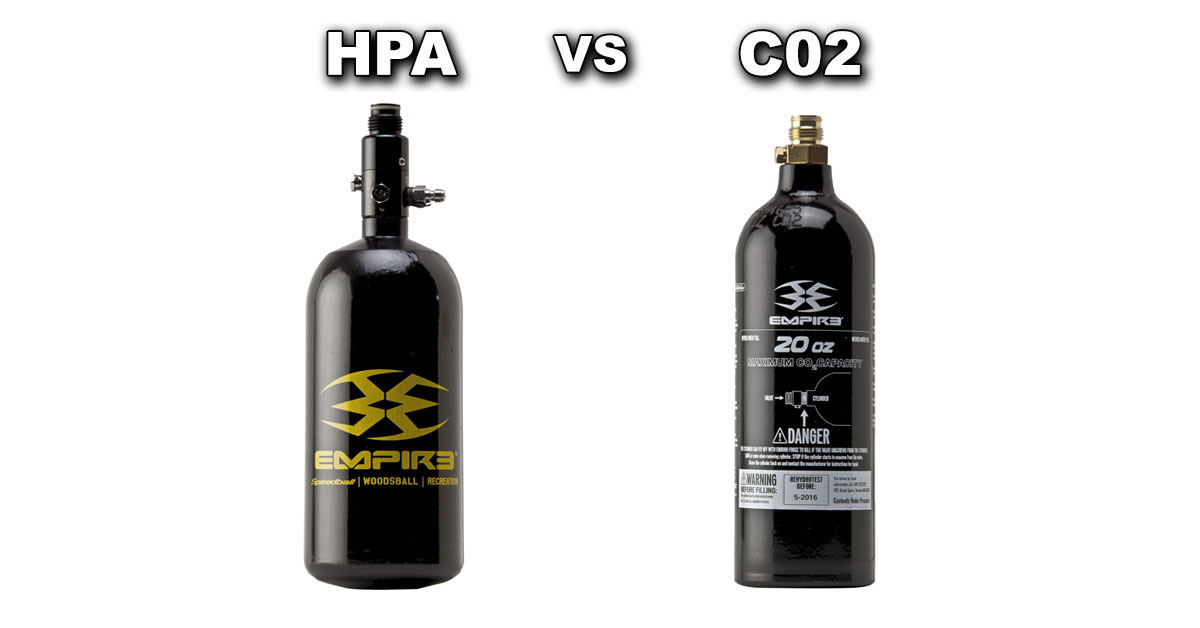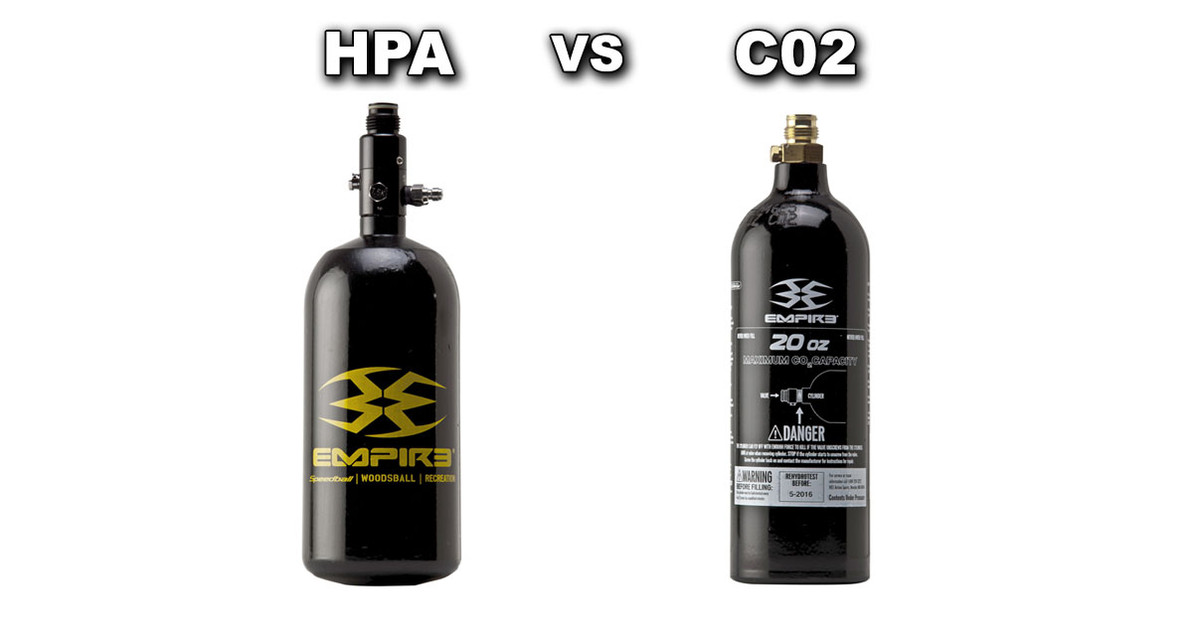High Pressure Air (HPA) VS C02

Many players buying their first marker setup are unfamiliar with which pressure system they should be using with their markers. That is to say it is a choice between HPA (High Pressure Air) and CO2 (Carbon Dioxide). Many experienced players share the opinion that HPA is an overall better choice but are not given the reasons why.
This article is meant as a short tutorial outlining differences, pros, and cons of each gas. While this list will show that HPA is nearly always a better choice, it will also highlight some of the situations in which CO2 may be a better option.
The first difference most players notice is the cost difference between a CO2 tank and an HPA tank. CO2 tanks rarely cost more than $30 , while HPA tanks can run anywhere between $60 to almost $200. The higher cost of a High Pressure Air tank may deter a new player from spending more money, however, over the life of a steel tank (which is generally 5 yrs.} you will save that money. The majority of paintball fields offer free HPA fills to equipment owners, while charging a a fee for each CO2 fill. This is because most fields can replenish an HP Air supply with a special compressor. CO2 requires the purchase from a third party company. That cost is then passed onto the customer. The average field charges $5 to fill a CO2 tank. Do the math and you will see that after approximately 12 fills you would have covered the initial cost of a steel HPA tank.
Wear and Tear
When CO2 is stored under pressure most of it is in the form of a liquid at the bottom of the tank. When CO2 leaves the tank and travels through your marker, it expands into a gas and cools to sub zero temperatures. This rapid cooling can cause the rubber o-rings inside your marker to shrink, harden, and sometimes break. While the damage caused by using CO2 is easily and cheaply replaced, the bottom line is that you will likely have to replace your o-rings more often than you would if you were using HPA.
CO2 tanks must also be removed from the marker in order to be filled, whereas, an HPA tank can be filled while still attached. HPA tanks are filled via a small fill nipple that is not present on CO2 tanks. This means that after the CO2 tank has been filled, you must screw it back into the marker's regulator while under pressure. This causes the thread wear on both the tank and on the regulator.
Ease of use
Filling a Co2 tank is a lengthier process compared to HPA. With HPA, a quick- connect hose is attached to the fill nipple, it fills for approximately 15 seconds, the hose is detached and you're done. With CO2, the tank is attached to a fill station and then partially filled. Once it is partially filled, some of the CO2 must be vented from the tank in order to drive the temperature of the tank down, which will allow more CO2 to be filled in the tank. This fill-vent-fill process is repeated until the tank is full, at which point it is removed from the fill station and reattached to the marker. The entire process takes 1 to 2 minutes, and with no real way to tell how much CO2 is in the tank without weighing it. Another drawback to the CO2 system is that there is no gauge on the tank. You could run out in the middle of a game. A gauge on the HPA tank at least indicates when you are getting low.
Output pressure and velocity
The output pressure of a CO2 tank is dictated by the temperature of the tank, and on most markers that will have a drastic effect on your velocity. If the tank gets too hot, the pressure rises which causes your velocity to rise, which could result in your marker shooting above the field paintball speed limit and causing injury, or even damage to the marker. More common than that is when the tank gets too cold, as often happens in cold weather or when firing very quickly. When the marker is firing in automatic or simply firing rapidly, the tank cools as it empties. This causes the output pressure to drop, resulting in a drop in velocity. Losing velocity means your paintballs won’t go as far, and might not even break on target, which is a serious disadvantage.
While it is clear that HPA is the superior choice for most consumers, CO2 still fills an important role in small, new, or privately operated paintball fields. Most HPA compressors capable of filling to high pressure used in paintball are large, expensive, complicated and noisy machines. Many new fields cant afford to invest in a compressor when they first open, and operating on CO2 can be a more affordable option until the field is seeing enough business to justify buying a compressor. With privately owned fields that see a smaller volume of business, it is much easier to acquire and operate a small CO2 fill station than an HPA compressor operation. When buying your tank, consider where you will be playing and whether they are equipped with HPA, CO2, or both.
If you're in the market for a new tank, and still on the fence between HPA and CO2, I hope this helps inform your decision. There are, of course, many different kinds of HPA and CO2 tanks, with different capacities, shapes, sizes, and price tags. Even if you have made up your mind on getting an HPA or CO2 tank, which tank is right for you is entirely up to your personal preference.
Some words regarding safety:
The vast majority of paintball markers are capable of operating on either HPA or CO2, but there are a growing number of markers that are HPA only, and using CO2 would cause damage to the marker. It is essential that you establish whether your marker can use CO2 safely before doing so.
CO2 tanks are not capable of holding HPA, and HPA tanks are not capable of holding CO2; filling either tank with a gas it is not designed to contain is incredibly dangerous. The tanks are not interchangeable, and they are not meant to hold anything but the specific gas they were designed for. Adding oil or debris into the tank can also cause the tank to rupture.
All HPA and CO2 tanks have a shelf life, depending on the type of tank and where it was manufactured. The average life span of steel tanks whether HPA or CO2 is approximately 5 yrs.. Tanks are stamped with a date code that indicates the date of manufacture. It is within 5 yrs. of that date when a tank must be hydrostatically tested. The testing will result in a pass or fail. After a tank is hydro tested, it is either discarded or a sticker with a new date is applied to it. Keep in mind that testing costs as much as a new HPA tank.
If you are new to the sport it is strongly recommended that you buy a new tank from a retailer, which will ensure that the tank is not damaged or expired. When used properly, CO2 and HPA tanks are perfectly safe, but it is important to remember the kind of tremendous pressure that is inside the tank. Using a tank that is past its hydro date, damaged, or improperly filled can be extremely dangerous.
Recent Posts
-
Paintball Extravaganza 2018 Live Blog
Its that time of year again, when new and awesome paintball gear is shown off. Follow …18th Feb 2018 -
Paintball Extravaganza 2016
…22nd Feb 2016 -
Milsig Maxim II: Tempest Live Blog
Defcon Paintball is proud to announce we will be hosting Milsig Maxim II at our Mississaug …3rd Dec 2015


